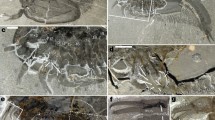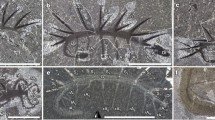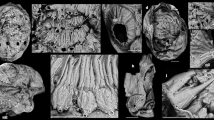Abstract
The appearance of coelenterates marks the real beginning of metazoan evolution. It therefore has a prominent position in the origin and evolutionary history of organisms, and is also a pivotal question of evolutionary biology. Punctatus is an extinct, ancient marine animal from the early stage of the Cambrian explosion, occurring at the lowermost Cambrian of both Kuanchuanpu (Ningqiang, Shaanxi) and Maidiping (Emei, Sichuan) areas. Punctatus has been studied for many years since the discovery of its fragments. Systematic and phylogenetic analysis has long been limited because of the rarity of complete specimens. In order to improve research into Punctatus, more than ten thousand globular fossils were recovered by means of “Chemistry Retting”. On the basis of the study of these globular fossils, a series of Punctatus fossils with cone parts and finely preserved soft-tissue mouthparts and fossilized metazoan embryo were recovered. Through research on characteristics such as shape, modality and structure of these fossils symbiotic with Punctatus emeiensis, the author found many possible embryo fossils including the evidence of gastrula-stage animal fossils. The sequence of fetation might have appeared on the corolliform oral region of Punctatus emeiensis. A study of the soft tissues, functional morphology and the sequence of embryo fossils shows evidence that Punctatus resembles coelenterate polyps in systematic classification. Perhaps it also represents an ancestor of the coelenterate with an original tentacle. A comparison with the real “tentacle animal” found in the Chengjiang Fauna, shows that the original tentacle is very tiny and its function range is limited. This reveals the primitive nature of the animal. Although the original tentacle is so small, it does exist, representing the first big step towards the real flexible tentacle with a strong function from the early evolving tentacle.
Similar content being viewed by others
References
Bengtson S, Yue Z (1997). Fossilized metazoan embryos from the earliest Cambrian. Science, 277(5332): 1645–1648
Chen J Y, Andreas B, Dieter W, et al (2004). Lower Cambrian yolk-pyramid embryos from southern Shaanxi, China. Progress in Natural Science, 14(2): 167–172
Conway M S, Chen M E (1990). Tommotiids from the Lower Cambrian of South China. Journal of Paleontology, 64(2): 169–184
Conway M S, Chen M E (1992). Carinachitids, hexaconulariids, and Punctatus: Problematic metazoans from the Early Cambrian of South China. Journal of Paleontology, 66(3): 384–406
He T G (1987). Early Cambrian conulariids from the Yangtze platform and their early evolution. Journal of Chengdu College of Geology, 14(2): 7–18 (in Chinese with English abstract)
He T G, Yin J C, Ding L F, et al (1980). The Palaeontology and Sedimentary Environment of the Sinina System in Emei-Ganluo Area. Chengdu: Sichuan People Publishing House (in Chinese with English abstract)
Hua H, Chen Z, Zhang L Y (2004). Phosphatized metazoan embryos fossils of blastulation and gastrulation from the earliest Cambrian in southern part of Shaanxi, China. Chinese Science Bulletin, 49(2): 177–180
Peng S C (2005). Towards a new global subdivision of the Cambrian System. Journal of Stratigraphy, 29(2): 297–302
Qian Y (1999). Taxonomy and Biostratigraphy of Small Shelly Fossils in China. Beijing: Science Press, 22–117
Runnegar B (1985). Shell microstructures of Cambrian mollusks replicated by phosphate. Alcheringa, 9: 245–257
Runnegar B, Bentley C (1983). Anatomy, ecology and affinities of the Australian Early Cambrian bivalve Pojetaia runnegari. J Palaeont, 57: 73–92
Steiner M, Li G X, Qian Y, et al (2004). Lower Cambrian small shelly fossils of northern Sichuan and southern Shaanxi (China), and their biostratigraphic importance. Geobios, 37: 259–275
Xiao S H, Knoll A H (1999). Fossil preservation in the Neoproterozic Doushantuo phosphorite lagerstatte. Lethaia, 32: 219–240
Yang X H, He Y X, Deng S H (1983). On the Sinian-Cambrian boundary and the small shelly fossil assemblages in Nanjiang area, Sichuan. Bulletin of the Chengdu Institute of Geology and Mineral Resources, Chinese Academy of Geological Sciences, 4: 91–110 (in Chinese with English abstract)
Yin C Y (1998). Fossilized embryos the historical witness of Cambrian explosion. Chinese Science Bulletin, 43(17): 1793–1794
Yue Z, Bengtson S (1998). Phosphatized metazoan embryo fossils in Cambrian explosion. Chinese Science Bulletin, 43(17): 1858–1882
Yue Z, Xing Y S (1984). The Sinian-Cambrian boundary in southwestern part of Shaanxi. In: Xing Y S, ed. Special Issue on the Sinian-Cambrian Boundary of China. Bulletin of the Institute of Geology, Chinese Academy of Geological Sciences, 10: 111–125 (in Chinese)
Author information
Authors and Affiliations
Corresponding author
Additional information
Translated from Journal of Acta Palaeontologica Sinica, 2006, 45(2): 182–194 [译自: 古生物学报]
Rights and permissions
About this article
Cite this article
Liu, Y., Li, Y., Shao, T. et al. Phosphatized Punctatus with mouthparts and its embryo fossils from the Lower Cambrian of Ningqiang, south Shaanxi, China. Front. Earth Sci. China 1, 1–11 (2007). https://doi.org/10.1007/s11707-007-0001-x
Issue Date:
DOI: https://doi.org/10.1007/s11707-007-0001-x




